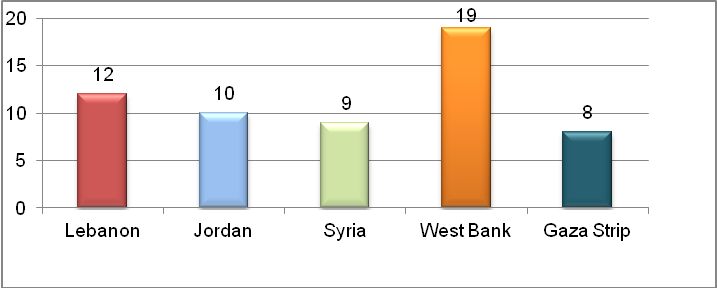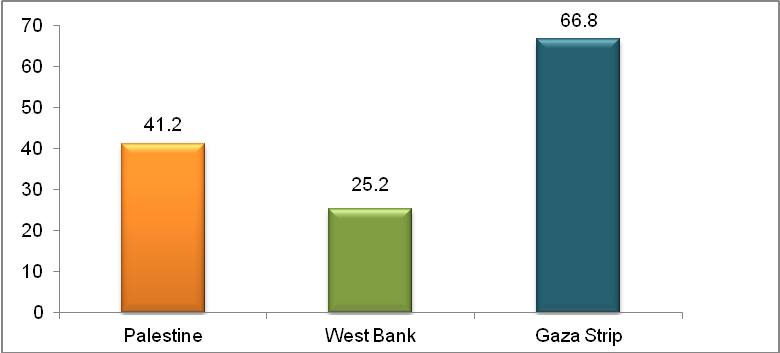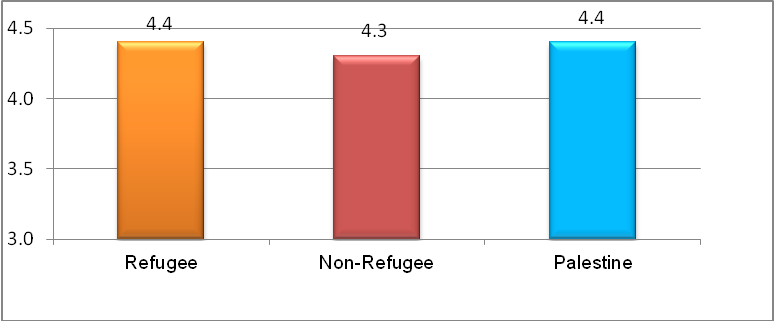Palestinian Central Bureau of Statistics (PCBS)
On the Eve of the International Day of Refugees (20/06/2015)
66% of Palestinians who were living in Historic Palestine (British-Mandated Palestine) in 1948 were Expelled and Displaced
The human plight and tragedy that has befallen on the Palestinian people in 1948, a devastating tragedy was expelled and displaced from land seized by Israel as about 957 thousand Palestinian Arabs, representing 66.0 % of the total Palestinians who were living in historic Palestine on the eve of the war of 1948, according to UN estimates in 1950.
Number of Official Palestinian Camps as Recognized by UNRWA by the Residential Country

Source : According to the data of UNRWA on the Palestinian Refugees. http://www.unrwa.org
Several official estimates on the number of Palestinian refugees on the eve of the 1948 war was released from various sources. However, United Nations released two estimates: the first referred to the number of Palestinian refugees that amounted to about 726 thousand refugees as based on the estimates of the United Nations in 1949. And the second that amounted to 957 thousand refugees as based on estimates of 1950.
5.5 million Registered Refugees in UNRWA
UNRWA Records indicated that the number of registered Palestinian refugees on the first of July 2014 amounted up to about 5.5 million and these figures represented the minimum number of Palestinian refugees. Palestinian refugees in the West Bank who are registered with UNRWA as in the mid of 2014 accounted up to 16.8 % of the total refugees registered with UNRWA against 24.2% in Gaza Strip. At the level of the Arab countries, the percentage of Palestinian refugees registered with UNRWA in Jordan, amounted up to 39.8% of the total Palestinian refugees while the percentage of Palestinian refugees registered with UNRWA in Lebanon and Syria reached 8.9% and 10.3% respectively.
Percentage Distribution of Palestinian Refugees by the Residential Country as in 1/7/2014, (According to the data of UNRWA on the Palestinian Refugees )

Source : According to the data of UNRWA on the Palestinian Refugees. http://www.unrwa.org
41% of the total Population in Palestine are Refugees
Data refer that the percentage of the population of refugees in Palestine in 2014 is estimated at 41.2% of the total Palestinian population living in Palestine, and data indicated that 25.2% of the population in the West Bank are refugees, while the percentage of refugees in Gaza Strip is about 66.8%.
Percentage of Refugees in Palestine by Region, 2014

Source: Palestinian Central Bureau of Statistics 2015. Database of the Labor Force Survey,
the fourth quarter 2014. Ramallah -Palestine
Palestinian Refugees are Characterized as a Youngsters Community
Statistical data of 2014 indicated that the percentage of persons aged less than 15 years in Palestine reached 39.9% (as of 40.9% for refugees and 39.2% for non- refugees), while the percentage of elderly aged 60 years and over among refugee reached 4.2% of the total refugees while for non- refugees reached 4.6%.
Palestinian Refugee Women living in Palestine are the most Fertility
Statistical data of 2010 indicated that the total fertility rate for the period (2008-2009) in Palestine amounted to 4.4 births, and the mean number of the children ever born amounted to 4.3 births for 2010. When compared to those rates by refugee status, it is clear to us that there are light differences between total fertility rates and the mean number of children ever born as the total fertility rate and the mean number of children among refugee reached 4.4 births and 4.3 births respectively, while these rates among non-refugee reached 4.3 and 4.2 births respectively .
Fertility Rates in Palestine by refugee Status (2008 -2009)

Source: Palestinian Central Bureau of Statistics, 2015. Palestinian family Survey Database, 2010.
Ramallah -Palestine
Palestinian Refugees are poorer than non-refugees
Poverty index showed that poverty rate in Palestine among refugees according to monthly household real consumption patterns reached 31.2% in 2011, compared to 21.8% for non-refugees
Data indicated that refugee population of camps in Palestine are poorer compared with rural and urban population. Data of real monthly consumption patterns showed that 35.4% of the camps in Palestine are suffering from poverty compared to 19.4% in rural areas and 26.1% in urban areas. These high rates of poverty in refugee camps may be traced back to high unemployment rates and large size of households in the camps compared with other households in urban and rural areas, as well as data indicated that their is high poverty rate in Gaza Strip as a whole where Gaza Strip has highest rates of poverty, regardless of locality type, as percentage of poverty among individuals in Gaza Strip reached 38.8% against 17.8% in the West Bank.
Unemployment rate is high for both refugees and non-refugees
The results of the Labor Force Survey in 2014 showed that the participation rate in labor force among refugees aged 15 years and over whom residing in Palestine were 45.7% against 45.8% for non- refugees. Also, the rate of female participation of refugee living in Palestine reached 20.9% against 18.4% for non- refugees. Data indicated that there is a clear difference on the level of unemployment rate among refugees and non-refugees, as unemployment rate among refugees reached up to 33.7% compared to 22.3% among non-refugees.
One-third of the Refugees are working as Specialists and Technicians
In 2014, the profession of "technicians, specialists, assistant, and clerks" considered as the most accommodating profession among refugees and non- refugees in Palestine alike as refugees amounted to 34.3% while the non-refugees reached 22.1%. Also, legislators and senior management staff represented the lowest percentage for both of refugees and non-refugees with a variation by 2.9% for refugees and 3.8% for non-refugees.
An Increase in Percentages of Educational Attainment among Refugees
The percentage of illiteracy among Palestinian refugees in 2014 for individuals aged 15 years and over reached 3.3%, while among non-refugee reached 3.8 %. As a percentage of Palestinian refugees aged 15 years and over who obtained a bachelor's degree or higher reached 13.7 % of the total refugees aged 15 years and over against 11.6 % for non-refugees .
About 60% of the Refugee Households live in an Apartment
Data of 2013 indicated that 47.3% of the households of Palestine live in an independent house, the percentage among non-refugee was 54.2% against 36.9% for refugees, and the percentage of household living in an apartment reached 50.8% (44.5% non-refugee against 60.2% for refugee). The percentage of refugee households living in a rented accommodation reached 10.9% of the total refugee households and 77.8% for refugee households are living in owned housing unit.
The situation of Palestinians Refugees in Diaspora:
Palestinians refugees in Jordan
The socio-economic conditions of the Jordan's Palestinian camp refugees study 2011, which prepared by FAFO shows that 39.9% of persons in the Palestinian camps refugees in Jordan aged under 15 year old , while the percentage of elderly (65 years and over) was 4.3%, and the average of household size was 5.1 persons. The data also indicated that the percentage of illiteracy rate among the Palestinian camps refugees in Jordan aged 15 and over was 8.6%.
Palestinians refugees in Lebanon
Data available on Palestinians living in Lebanon in 2011 showed that 31.1% of the population were below the age of 15, 6.1% were aged 65 years and over. The sex ratio was 98.2 males per hundred females in 2011. Data available for 2011 indicated that the average Palestinian household size was 4.4 persons, the total fertility rate was 2.8 births per woman, the infant mortality rate was 15.0 per thousand live births and the mortality rate for children below the age of five was 17.0 per thousand live births in the same year.
 عربي
عربي